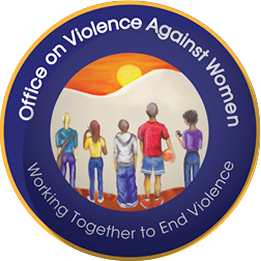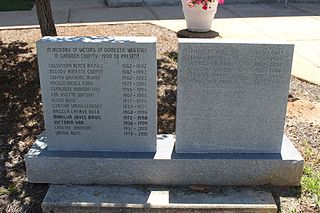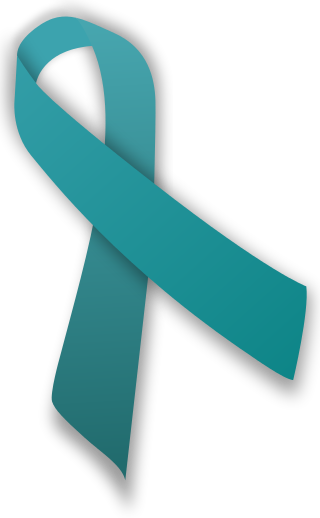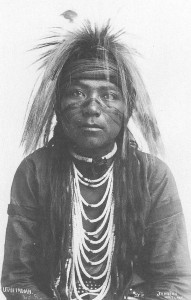A violent crime, violent felony, crime of violence or crime of a violent nature is a crime in which an offender or perpetrator uses or threatens to use harmful force upon a victim. This entails both crimes in which the violent act is the objective, such as murder, assault, rape and assassination, as well as crimes in which violence is used as a method of coercion or show of force, such as robbery, extortion and terrorism. Violent crimes may, or may not, be committed with weapons. Depending on the jurisdiction, violent crimes may be regarded with varying severities from homicide to harassment.
Some victims of rape or other sexual violence incidents are male. Historically, rape was thought to be, and defined as, a crime committed solely against females. This belief is still held in some parts of the world, but rape of males is now commonly criminalized and has been subject to more discussion than in the past.

The Violence Against Women Act of 1994 (VAWA) is a United States federal law signed by President Bill Clinton on September 13, 1994. The Act provided $1.6 billion toward investigation and the prosecution of violent crimes against women, imposed automatic and mandatory restitution on those convicted, and allowed civil redress when prosecutors chose not to prosecute cases. The Act also established the Office on Violence Against Women within the U.S. Department of Justice.

The United States Office on Violence Against Women (OVW) was created following the Violence Against Women Act (VAWA) of 1994. Office on Violence Against Women. Retrieved 2013-03-23.</ref> The Act was renewed in 2005, 2013 and again in 2022. The Violence Against Women Act legislation requires the Office on Violence Against Women to work to respond to and reduce violence against women in many different areas, including on college campuses and in people's homes. VAWA requires Office on Violence Against Women to administer justice and strengthen services for victims of domestic violence, dating violence, sexual assault, and stalking.
Rape by gender classifies types of rape by the sex and gender of both the rapist and the victim. This scope includes both rape and sexual assault more generally. Most research indicates that rape affects women disproportionately, with the majority of people convicted being men; however, since the broadening of the definition of rape in 2012 by the FBI, more attention is being given to male rape, including females raping males.
Statistics on rape and other acts of sexual assault are commonly available in industrialized countries, and have become better documented throughout the world. Inconsistent definitions of rape, different rates of reporting, recording, prosecution and conviction for rape can create controversial statistical disparities, and lead to accusations that many rape statistics are unreliable or misleading.
Domestic violence occurs across the world, in various cultures, and affects people across society, at all levels of economic status; however, indicators of lower socioeconomic status have been shown to be risk factors for higher levels of domestic violence in several studies. In the United States, according to the Bureau of Justice Statistics in 1995, women reported a six times greater rate of intimate partner violence than men. However, studies have found that men are much less likely to report victimization in these situations.
Rape in the United States is defined by the United States Department of Justice as "Penetration, no matter how slight, of the vagina or anus with any body part or object, or oral penetration by a sex organ of another person, without the consent of the victim." While definitions and terminology of rape vary by jurisdiction in the United States, the FBI revised its definition to eliminate a requirement that the crime involve an element of force.

Domestic violence is a form of violence that occurs within a domestic relationship. Although domestic violence often occurs between partners in the context of an intimate relationship, it may also describe other household violence, such as violence against a child, by a child against a parent or violence between siblings in the same household. In the United States, it is recognized as an important social problem by governmental and non-governmental agencies, and various Violence Against Women Acts have been passed by the US Congress in an attempt to stem this tide.
Violence against men comprises violent acts that are disproportionately committed against men or boys. Men are overrepresented as both victims and perpetrators of violence. Violence against women is the opposite category, where acts of violence are targeted against the female gender.

Native American reservation inequality underlies a range of societal issues that affect the lives of Native American populations residing on reservations in the United States. About one third of the Native American population, about 700,000 people, lives on an Indian Reservation in the United States. Reservation poverty and other discriminatory factors have led to persisting social inequality on Native American reservations. Disparities between many aspects of life at the national level and at the reservation level, such as quality of education, quality of healthcare, substance use disorders, teenage pregnancy, violence, and suicide rates are significant in demonstrating the inequality of opportunities and situations between reservations and the rest of the country.

Missing and Murdered Indigenous Women are instances of violence against Indigenous women in Canada and the United States, notably those in the First Nations in Canada and Native American communities, but also amongst other Indigenous peoples such as in Australia and New Zealand, and the grassroots movement to raise awareness of MMIW through organizing marches; building databases of the missing; holding local community, city council, and tribal council meetings; and conducting domestic violence trainings and other informational sessions for police.
The feminist pathways perspective is a feminist perspective of criminology which suggests victimization throughout the life course is a key risk factor for women's entry into offending.
Police brutality is defined as the use of excessive force by law enforcement personnel while performing their official duties in an abusive and unjustified manner. Police brutality can also include psychological harm through the use of intimidation tactics beyond the scope of officially sanctioned police procedure.
Suicide among Native Americans in the United States, both attempted and completed, is more prevalent than in any other racial or ethnic group in the United States. Among American youths specifically, Native American youths also show higher rates of suicide than American youths of other races. Despite making up only 0.9% of the total United States population, American Indians and Alaska Natives (AIANs) are a significantly heterogeneous group, with 560 federally recognized tribes, more than 200 non-federally recognized tribes, more than 300 languages spoken, and one half or more of them living in urban areas. Suicide rates are likewise variable within AIAN communities.

Sexual assault of LGBT people, also known as sexual and gender minorities (SGM), is a form of violence that occurs within the LGBT community. While sexual assault and other forms of interpersonal violence can occur in all forms of relationships, it is found that sexual minorities experience it at rates that are equal to or higher than their heterosexual counterparts. There is a lack of research on this specific problem for the LGBT population as a whole, but there does exist a substantial amount of research on college LGBT students who have experienced sexual assault and sexual harassment.
Violence against women in the United States is the use of domestic abuse, murder, sex-trafficking, rape and assault against women in the United States. It has been recognized as a public health concern. Culture in the United States has led towards the trivialization of violence towards women, with media in the United States possibly contributing to making women-directed violence appear unimportant to the public.

The epidemic of missing and murdered Indigenous women (MMIW) is not exclusive to any region of the United States, but some states have a higher number of cases. Utah ranked 8th in the United States for the number of missing and murdered Indigenous women. The state's capital, Salt Lake City, was the city with the 9th highest number of cases of MMIW.
Sex trafficking on Native American reservations in the United States began in the 18th century, as the American Revolution with its patterns of relocation, chaos, and conquest of Native American populations, inspired periods of instability for years to come. This instability would then cause cycles of generational trauma which created increased vulnerability to substance abuse, violence, poverty, and child neglect, therefore, increasing their susceptibility to sex trafficking.
Violence against indigenous women often has higher rates than violence against non‐indigenous women.






